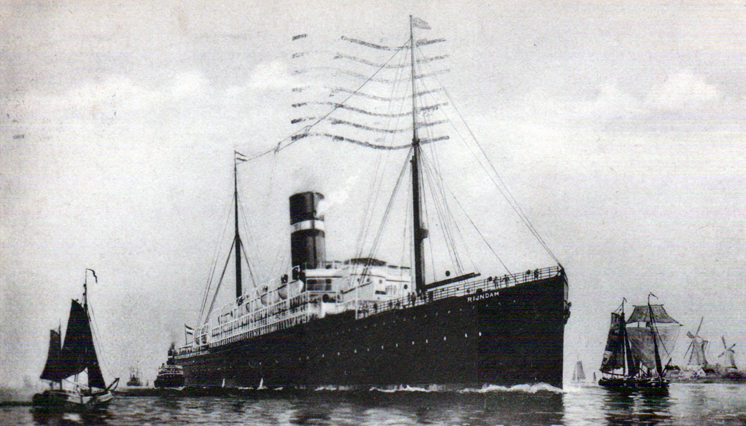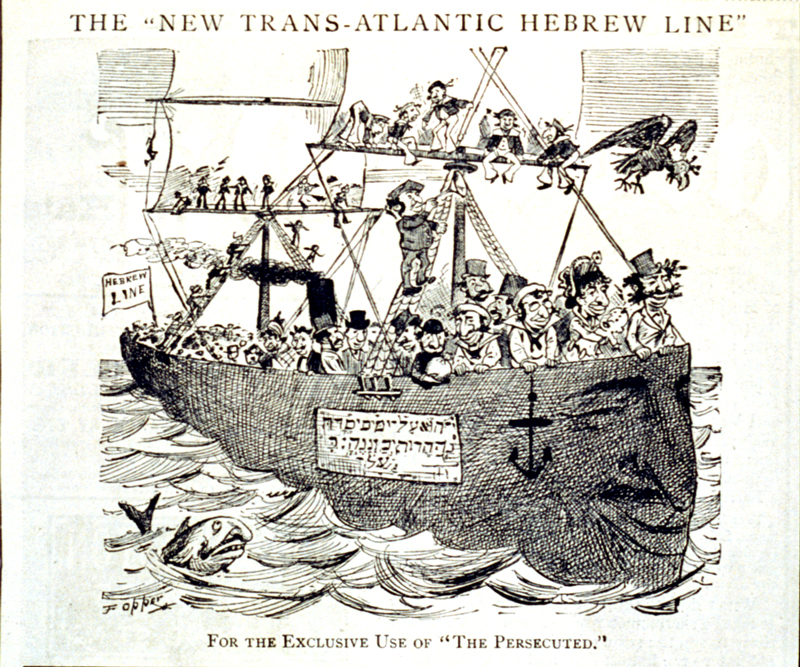All Aboard
On August 30, 1914, a riot erupted on the corner of Orchard and Canal Streets on New York’s Lower East Side. The fracas began outside Sender Jarmulowsky’s “bank,” one of the most revered businesses in the area. Two months into World War I and fearing the worst, thousands of Jews clamored to withdraw their savings. But Jarmulowsky was really more of a travel agent than a financier. He sold ship tickets, facilitating purchases by issuing modest loans and taking small deposits. As such, his business simply did not have the reserves to return all its clients’ funds at once. Enraged by their inability to access their savings, “a mob of 5,000 [demonstrated] against the bankers, the State Banking Department, and the district attorney, who, they thought, should get their money back for them” (New York Times, August 30, 1914, p. 10). Carrying Yiddish banners that proclaimed, “The 60,000 unfortunate depositors of the East Side banks demand their money!” the throngs marched to city hall, where they attacked clerks. The riot ended with nine arrests.
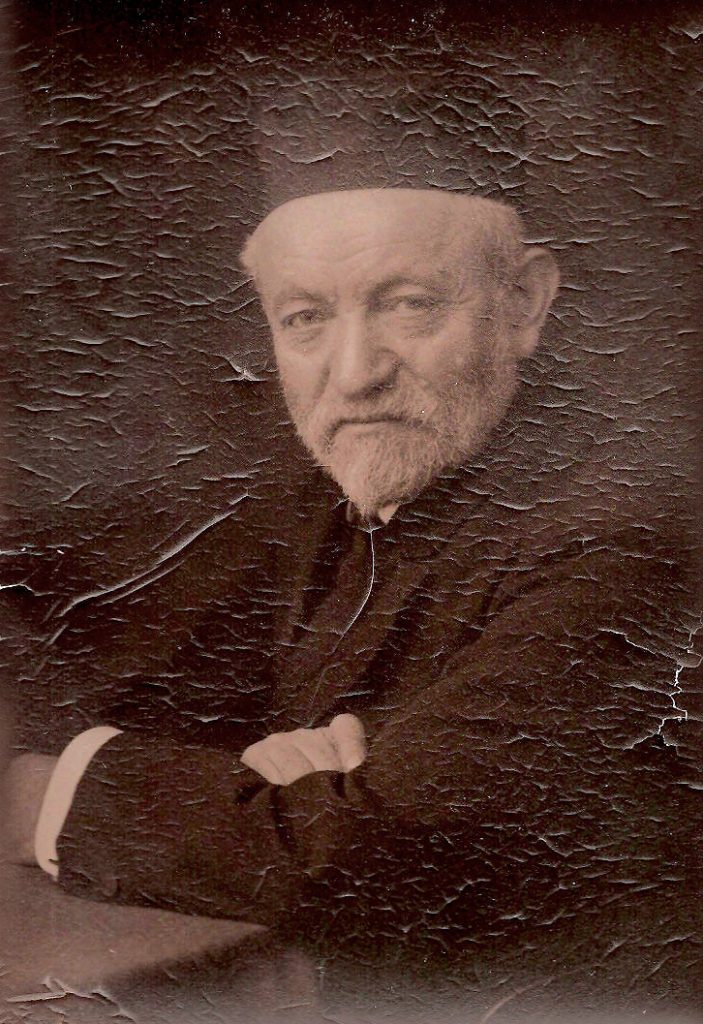 Courtesy of Frank Jarmuth
Courtesy of Frank JarmuthA rare portrait of Sender Jarmulowsky, circa 1905
Temple of Capitalism
Few today recognize the name Jarmulowsky or what was the “bank”’s main branch – nicknamed “the Temple of Capitalism” – which still looms over the tenements of the Lower East Side. But in the early 20th century, according to the Yiddish press, Jarmulowsky was known to “every Jew in both the Old and New World” as a purveyor of ship tickets. The rise of Sender Jarmulowsky’s business was tied to that of mass migration, which shaped the largest voluntary demographic shift in modern Jewish history. By the time the riot broke out, more than three and a half million Jews had decided to leave eastern Europe for new homes in North and South America, Europe, and Palestine. But they would have never reached their destination if not for brokers like Jarmulowsky, who cornered the market on tickets. Through his “passage and exchange offices” in New York and Hamburg, Jarmulowsky brought thousands of Jews to America. He also earned millions of dollars, using this wealth to establish important religious, cultural, and philanthropic institutions for Jewish immigrants in New York.
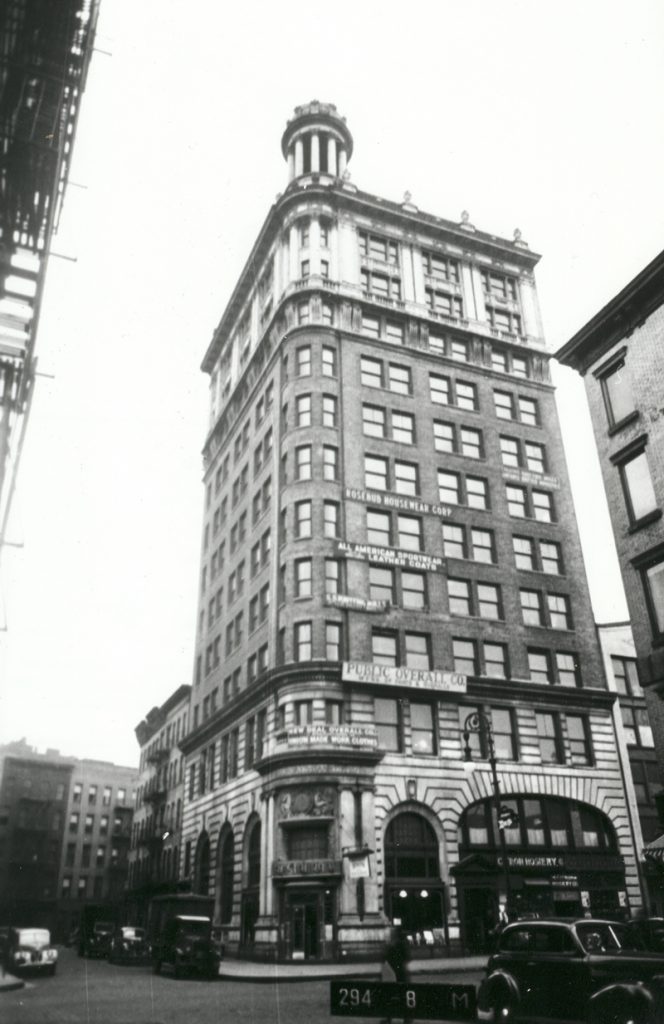 Architects & Builders XLIV (November 1912)
Architects & Builders XLIV (November 1912)Bank, credit company, or ticket agency? The Jarmulowsky building towered over the Lower East Side
Many scholars have studied the migration of eastern European Jewry. Sender Jarmulowsky’s career, however, highlights a lesser-known dimension of the story: economics. Middlemen like Jarmulowsky were key players in the transnational business of migration, negotiating on behalf of the individual Jewish migrant with shipping companies and national authorities. They treated their fellow eastern European Jews as commodities, transforming not only the demographics of American Jewry but also commercial banking in the U.S.
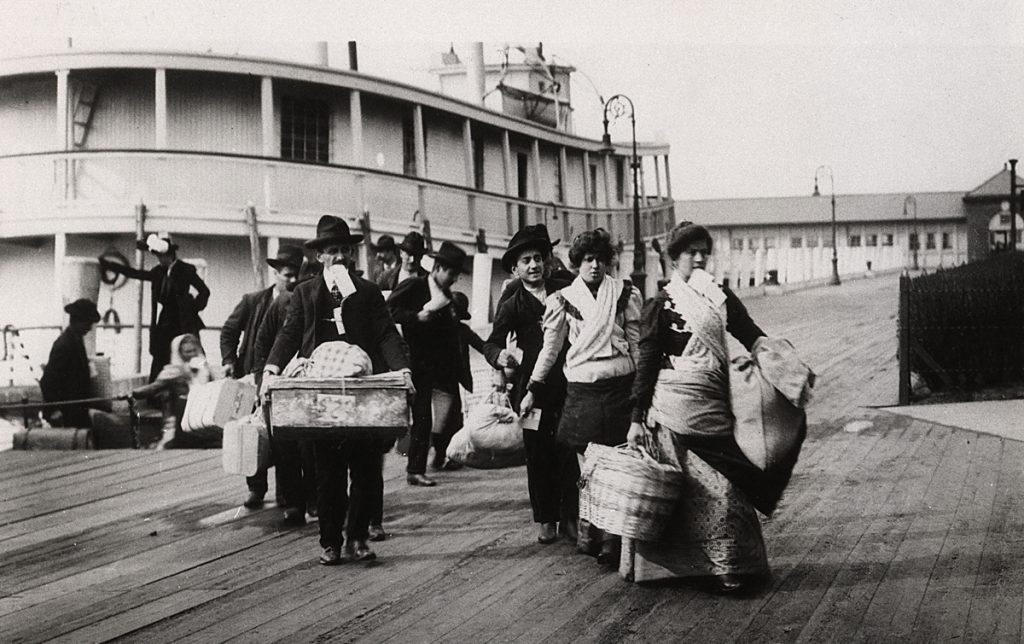 -
-At the docks. Immigrants disembark at Ellis Island, New York Harbor
Buying Short and Selling Long
Sender Jarmulowsky’s life exemplifies the radical transformative power of both migration and the business surrounding it. Born in 1841 in the small town of Grajewo, in the Lomza province of northeastern Poland, Jarmulowsky was orphaned at age three and raised by the local rabbi. Impressed with the boy’s intellect, the rabbi sent him to the Volozhin Yeshiva, from which he emerged with rabbinical ordination. Though penniless, Jarmulowsky was selected to wed Rebecca Markels, the daughter of a wealthy merchant. While this match should have enabled him to pursue a rabbinical career, he opted for the business world instead. Realizing there was money to be made by capitalizing on Jews’ growing desire to leave eastern Europe, Jarmulowsky set up an office with his father-in-law in Hamburg in 1868, through which he bought and sold steerage-class tickets to the United States. Jarmulowsky was far from alone in seeing the great business potential in mass migration. Several eastern European Jews opened branch offices in port cities such as Hamburg, Rotterdam, and London, where they sold tickets to compatriots and supplied a steady stream of passengers to rival shipping companies willing to undercut one another in order to fill their expanding fleets. The companies, in turn, vied for individual brokers’ favor, paying high commissions to push them to further develop their international order system.
TSS Rijndam, Holland- America line. Most immigrants from Europe arrived in ships such as this one
 Underwood & Underwood, Library of Congress, Prints and Photographs Division
Underwood & Underwood, Library of Congress, Prints and Photographs Division: The last stop on the way to the Promised Land. Immigrants waiting on the quay at Ellis Island for the ferry to New York, 1912
Jarmulowsky’s network of multilingual agents sold prepaid tickets and extended credit to prospective passengers throughout eastern Europe, exploiting weaknesses in the shipping companies’ sales policy. Seasonal fluctuations in ticket prices, coupled with the fact that the name of the individual to whom the ticket was issued could be changed at no extra charge, allowed Jarmulowsky to buy in bulk using fictitious travelers’ names during the winter, when prices were low (as few people ventured overseas in January and February). Since the tickets were valid for a year, he could then resell them for much more – but still less than the official prices charged by the shipping lines – the following summer. If there were no buyers, or if prices dropped, he could always cancel the tickets and get his money back – in which case his loss was limited to the five-percent cancellation fee charged by the shipping lines. Soon Jarmulowsky and his colleagues had attracted so many clients that representatives of the shipping lines complained that prices were effectively set by the brokers rather than by the shippers themselves. Court evidence later established that Jarmulowsky was making a profit of up to sixteen dollars a ticket.
Seeking new opportunities, Jarmulowsky moved to New York in 1873, where he offered eastern Europeans already in the United States installment plans and loans (at sixpercent interest) to cover the cost of bringing over their relatives. His business boomed. An article in Commentary recalled that “on [Rutgers] Square stood the green, iron-grilled skyscraper which housed the Jarmulowsky bank, a name known in every town, village, and hamlet across Europe. It was Jarmulowsky who provided the shiffskarten, the steamship tickets, to probably half the immigrants during the last two decades of the 19th century” (S. L. Blumenson, Commentary 10 [1950], p. 66).
As Blumenson’s recollections evocatively capture, the terms “bank” and “ship-ticket salesman” were interchangeable in the immigrants’ world. By 1900, Jarmulowsky ran the largest “bank” on the Lower East Side, holding the deposits of over thirtyfive thousand eastern European Jews, and exchanging millions of their greenbacks for Russian rubles to be sent back to Russia.
For these immigrants-in-themaking, Jarmulowsky’s success embodied the promise of America. The following thinly veiled journalistic portrait appeared in 1902:
Jobblousky’s bank is a revered institution of the East Side. It started in prehistoric times, that is to say, before the beginning of the great Russian immigration. The head of the house was a patriarchal gentleman…. Jobblousky was as rich as Rothschild…. Certainly he was worth millions, and his income rolled in very much as the waters of the Hudson sweep into the sea. He was the banker of the East Side. There were banks and bankers over there [in Russia], but where they did business in the hundreds, Jobblousky did it in thousands…. Trust companies accepted his signature as they would that of the treasurer of the United States. Every day, from two to five hundred people entered the bank to deposit or withdraw, to borrow or endorse, and all went away convinced that this bank was as firm as the eternal hills. (David Warfield and Margherita Hamm, Ghetto Silhouettes [New York: James Pott & Co.], pp. 81–2)
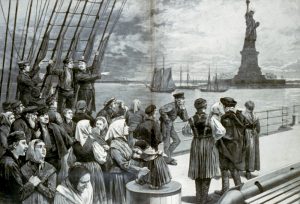 Library of Congress, Prints and Photographs Division
Library of Congress, Prints and Photographs DivisionAn Ocean Steamer Passing the Statue of Liberty: Scene on the Steerage Deck, wood engraving from Frank Leslie’s illustrated newspaper, July 2, 1887
Banking on Sunday
Jarmulowsky prospered by catering to Jewish immigrants in ways that mainstream American banks did not, offering office hours on Sunday (his longest business day), banking in Yiddish, and help translating documents and conducting correspondence in a multitude of languages. With the fortune he amassed, he soon became one of the greatest philanthropists of the Lower East Side, overseeing the erection of the Eldridge Street Synagogue (1887), founding the Orthodox Union (1898), and funding the Jewish Theological Seminary of America (1902). As the Yiddish newspaper Morgn zhurnal (June 4, 1912) summed up, “Jarmulowsky was living proof that in America one can be a rich businessman but also a true pious Jew.”
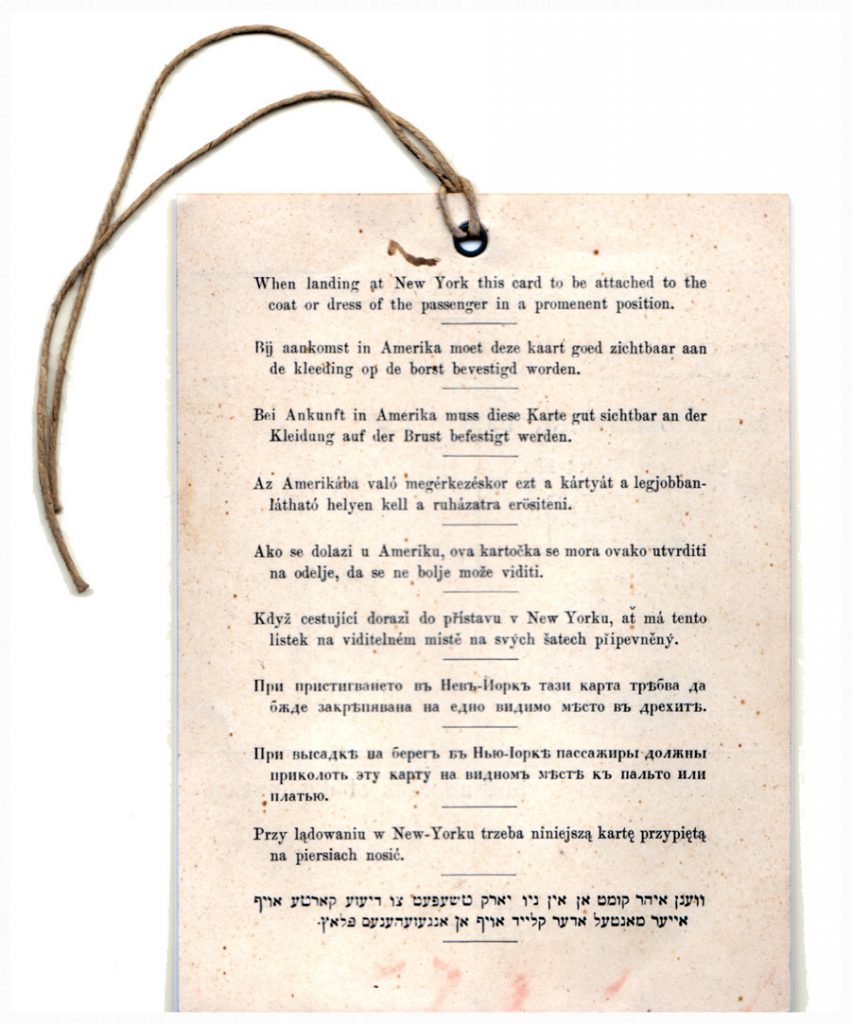 -
-Reverse side of the immigration tag attached to immigrants’ outer garments. The instructions appear in English, German, Russian, and Yiddish (in Hebrew characters)
But Jarmulowsky’s days as a ticket tycoon were numbered. Realizing that their fierce competition was undercutting profits, shipping lines formed a cartel to regulate ticket pricing. In 1896, they convened to divide up the market and fix rates. This North Atlantic Passenger Conference ended the price wars that had defined sea travel since the 1870s – and the profits earned by figures such as Jarmulowsky.
Despite this setback, Jarmulowsky and sons Meyer and Louis maintained their fortune through investment in real estate. Buying properties on the Lower East Side and later in Harlem, the family began to reap the benefits not only of bringing Jews to America, but of housing them there. Jarmulowsky abandoned the Lower East Side for Fifth Avenue in 1892. Meyer grew to love New York real estate and urged his family to construct a building worthy of their patriarch’s name. In 1912 the Jarmulowskys hired the esteemed architectural firm of Rouse & Goldstone to erect a twelvestory loft building on the same corner of Orchard and Canal Streets where Sender had established himself almost forty years earlier. Hoping to bring “uptown elegance” and class to the Lower East Side, as Architects & Builders Magazine put it, the Jarmulowskys purchased only the finest materials. The bank stood out not only in its sheer size, but because of the Tempietto-like dome that rose fifty feet above it. Known as “the Jewish Temple of Finance” (Hebrew Standard, March 1913), the building resembled nothing so much as a shrine of capitalism. New York Architectural Digest pored over the details of the bank’s façade and marble interior, while the Jewish press marveled at the beis midrash (study hall) located just beneath the main trading floor. The grand opening on May 6, 1912, marked by a parade, generated considerable excitement. The Forverts enthused that the dedication of this bank would be remembered forever as a turning point in American Jewish life.
A Run on the Bank
Sender Jarmulowsky did not live to see his temple transform America; he died less than a month later, on June 2. His obituary made the front page of all the major Yiddish newspapers. Yet this supposed multi-millionaire philanthropist left behind an estate worth only some half a million dollars. Where had Jarmulowsky’s fortune gone? The answer lay with his son.
Meyer Jarmulowsky’s real estate dabblings had tied up the bank’s capital. Buying up thirty-seven buildings in Harlem and East Harlem during a decade in which real estate speculators drove up prices from fifty dollars a lot to over three thousand, Meyer had intended to make millions by quickly reselling his purchases. But with the outbreak of war in July 1914, thousands stormed the bank, demanding their deposits so they could send money to relatives in Europe. With only $654,000 in reserve assets and over $1.73 million in liabilities, Jarmulowsky’s “bank” could not return their money. Accordingly, New York’s state bank superintendent, Eugene Lamb, closed the institution. The ensuing riot frightened city officials, who assigned the revered judge Learned Hand to settle the claims. The buildings owned by the Jarmulowsky family were placed in escrow, prompting myriad court cases and a number of precedent-setting judicial decisions. And new banking legislation prevented other small deposit banks from investing in real estate. New York City’s financial landscape was forever altered.
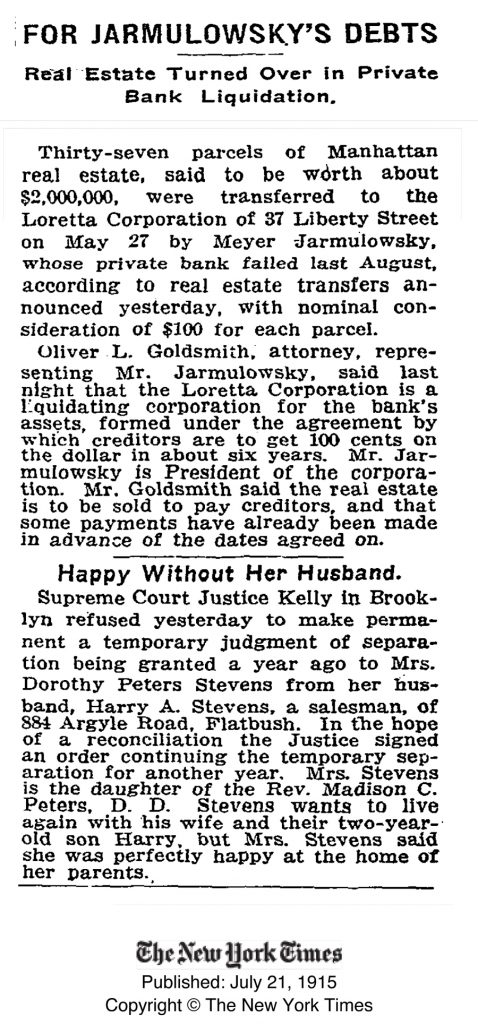 -
-New York Times article from July 21, 1915, describing the liquidation of the assets of Jarmulowsky’s bank
Unable to bear the family’s disgrace, Sender Jarmulowsky’s sons changed their last names to Jarmel and Jarmuth. But their shame should not eclipse the spectacular rise of the Jarmulowsky family or the centrality of commerce in the epic tale of Jewish mass migration to America. Indeed, how many of Emma Lazarus’ “huddled masses yearning to breathe free” could have come to America if not for Sender Jarmulowsky?

